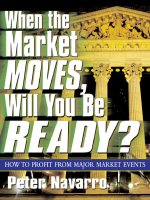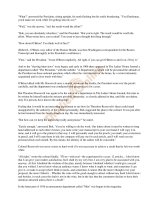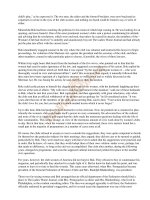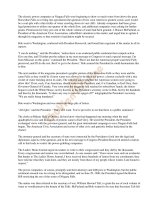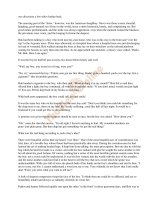Beat the market by edward o thorp
Bạn đang xem bản rút gọn của tài liệu. Xem và tải ngay bản đầy đủ của tài liệu tại đây (1.59 MB, 229 trang )
Other books by EDWARD O. THORP
Elementary Probability
Beat the Dealer
Other books by SHEEN T. KASSOUF
Evaluation of Convertible Securities
A Theory and an Econometric Model
for Common Stock Purchase Warrants
BEAT THE MARKET
A scientific Stock Market System
Random House New York
BEAT
THE MARKET
A Scientific Stock Market System
Edward O. Thorp, Ph.D.
Professor of Mathematics University of California at Irvine
Sheen T. Kassouf, Ph.D.
Assistant Professor of Economics University of California at Irvine
987
© Copyright, 1967, by E. O. Thorp and S. T. Kassouf
All rights reserved under International
and Pan-American Copyright Conventions.
Published in New York by Random House, Inc.,
and simultaneously in Toronto, Canada,
by Random House of Canada Limited.
Library of Congress Catalog Card Number: 67:22624
Manufactured in the United States of America
Designed by Betty Anderson
Contents
INTRODUCTION
3
Chapter
1 A SYSTEM IS BORN
7
First venture into the market. The market calls: boardrooms and
chartists. The “circus”. Fundamentals: the “better” they are, the
faster they fall. Textron and Molybdenum. The moment of discovery. Steady profits in bust and boom.
2 WARRANTS: OPTIONS ON THE FUTURE
15
Rediscovery of the system: Ed Thorp under a tree. What is a
warrant? Get rich quick? The warrant-stock diagram. The two
basic rules relating warrant prices to stock prices. Adjusted warrants
and adjusted exercise price. Reading the financial pages. Checking
the two rules. The warrant-stock law: predictability in the stock
market.
3 SHORT SELLING: PROFITS IN BAD TIMES
33
Short selling. Selling warrants short. Molybdenum warrants and
the avalanche effect.
4 THE BASIC SYSTEM
Hedging: high profit with low risk. Changing the mix. Deeper
insight into the basic system. The basic system: preview. An incredible meeting.
43
vi
Contents
5 THE SYSTEM IN ACTION: $100,000 DOUBLES
51
The Molybdenum story. Moly coda. Bunker-Ramo (Teleregister).
Catskill conference: Sperry Rand.
6 HOW TO USE THE BASIC SYSTEM
71
Identifying the listed warrants. Picking short-sale candidates. Using
the warrant-stock diagram. Which are best? Choosing the mix. How
much protection: Dividing your capital among the candidates. Final
points. Summary of the basic system.
7 FURTHER PROOF: THE HISTORICAL RECORD
91
A simplified mechanical strategy. The potential future for the basic
system. Performance through the 1929 crash.
8 MORE ON WARRANTS AND HEDGING
103
Over-the-counter, regional, and Canadian warrants. What determines
warrant prices? What is a warrant worth? Reverse hedging. Spotting
candidates for reverse hedging.
9 CAN ANYTHING GO WRONG?
127
Short squeezes. 1929 again? Volatile price movements. Extension of
warrant privileges. Banning of short sales. Extensive use of the basic
system.
10 THE GENERAL SYSTEM: THE EVALUATION OF
CONVERTIBLE SECURITIES
141
Scope of convertibles. Convertible bonds. Anatomy of a convertible
bond. Reverse hedging with Collins Radio “warrants.” Picking convertible bond situations. Best candidates for reverse hedging. Basic
system with latent warrants. The basic system with Dresser Industries “warrants.” Finding the best basic-system hedges with
convertible bonds. Convertible preferred stocks. Call options. Puts,
calls, and the basic system.
11 DECIPHERING YOUR MONTHLY STATEMENT
169
Your brokerage account. The cash account. The margin account.
The short account. Calculations in a mixed account. Applicability
to the basic system.
12 PORTFOLIO MANAGEMENT
Exploiting a rise in the price of the common. Exploiting a decline
in the price of the common. Diversification? Having several accounts. Long-term gains.
181
Contents
13 WHY WE ARE SHARING THE SECRET
vii
189
They wouldn’t believe us. I want to do it myself. The threat of
rediscovery.
14 WHAT THE FUTURE HOLDS
195
How much can be invested in the basic system? How much can be
invested by the entire system? A general solution for the stock
market.
APPENDIX
A Mathematics of the avalanche effect.
199
B Over-the-counter and Canadian warrants.
200
C Scientific proof that hedging can offer high expected return.
200
D The prediction of warrant prices.
201
E Basic-system hedge performance, 1946-1966.
204
REFERENCES
209
INDEX
213
BEAT THE MARKET
A scientific Stock Market System
Introduction
We present here a method by which investors can consistently make large profits. We have
used this method in the market for the past five years to earn 25% a year. We have made profits during two of the sharpest stock market drops of this century; we have made profits when
the stock market soared; and we have also made profits in stationary and churning markets.
We have used mathematics, * economics, and electronic computers to prove and perfect our theory. After reading dozens of books, investigating advisory services and mutual
funds, and trying and rejecting scores of systems, we believe that ours is the first scientifically proven method for consistent stock market profits.
This book analyzes convertible securities and their associated common stock. These
securities are now held in the portfolios of several million investors. More than 300 of the
3,500 securities traded on the New York and American stock exchanges are convertibles. Our
methods apply to these convertibles jointly with their more than 200 associated common
stocks. (We emphasize
* Some of the research which made this book possible is based in part upon mathematical research
supported in part by Air Force grant AF-AFOSR 1113-66.
that our profits generally come from both the common stock and the convertibles.) The total
of over 500 securities is about 15% of all the securities listed and has a market value of perhaps $50 billion.
We predict and analyze the price relationships which exist between convertible securities (warrants, convertible bonds, convertible preferreds, puts, and calls) and their common
stock. This allows us to forecast future price relationships and profits. We do not need to predict prices of individual securities in order to win.
The minimum amount required to operate the system is determined by the amount
required to open a margin account. This amount is subject to change. As we write, it is
$2,000. Our method does not require you to invest all your funds in it, though we expect most
readers will wish to do so. It is natural, for instance, to begin with a trial investment, increasing it as you gain skill, confidence, and success. If the total equity in your brokerage account
is at least $2,000, then you are free to invest any portion of it by our system, ranging from a
few dollars to the total amount.
We begin the book by telling how we discovered the system. Then, as needed background, we discuss warrants, short selling, and hedging. In the fifth chapter we illustrate the
system with investments made by one of the authors over a five-year period. The sixth chapter shows the reader how to select his own investments with that part of our method we call
the basic system. Next we present the historical performance of the basic system, which averaged more than 25% a year over a seventeen-year period.
When the reader finishes the first nine chapters, he can successfully operate his own
stock market investments. Chapter 10 shows how to extend our analysis to the entire area of
convertible securities.
4
We conclude by discussing accounting and monthly statements, portfolio management,
and the future for our method.
The scientific proof of the basic system, indicated in the exposition, consists of four
parts:
(1) We show (Chapter 7) that the basic system gained more that 25% per year
for seventeen years (after commissions but before taxes). We also show that
when stocks fell from September 1929 to 1930, the basic system could have
doubled an investment.
(2) A statistical analysis, with the aid l basic-system
opportunities from 1946 to 1966 (Appendix E).
(3) Our five-year cash record of no losses and an average return of 25% per
year with the method. One of the authors more than doubled $100,000 in
just four years (Chapter 5).
(4) A theoretical argument that convinced colleagues in whom we confided
(Appendix C).
The tables and charts in the book make our strategy easier to use. For the interested
reader, appendixes indicate the technical foundations for our method. this supplementary
material need not be read to successfully employ our winning method.
We do not claim that you can breeze through this book and then shake the money from
trees. This book needs to be studied. However, we intend Beat the Market to be useful and
profitable to the entire investment public, from professionals to beginners.
5
Chapter 1
A SYSTEM IS BORN
On October 5, 1961, Sheen Kassouf began a series of investments which averaged 25% a
year over the next five years. Kassouf tells of his trial and rejection of the usual stock market approaches and how he then discovered the basis of our system.
First Venture into the Market
In 1957 I sought investment opportunities. The advertisements of brokerage houses and advisory services implied that stock market profits were just a matter of following their procedures. I subscribed to a respected advisory service and received hundreds of pages of financial data, charts, and advice. Emerson Radio was rated “promising” so I purchased 100
shares.
The stock market had been declining and now this general decline quickened. Analysts
and financial writers could not agree on an explanation. They blamed Sputnik, the economy,
credit and banking conditions, foreign interests selling stock, deteriorating “technical” position, and “wedge formations” in the stock averages.
I continued to buy Emerson. My broker * asked, “What shall I
* Most investors place orders with a registered representative, also known as a customer’s man or
an account executive. We replace these cumbersome terms with the widely used but slightly inaccurate
“broker.”
do tomorrow for your account if it drops again?” The question jolted me. My loss was now
$1,500. How much further could it fall?
Early in 1958 Emerson rose, and I sold out at a profit of $500. A year later Emerson
tripled in price. The enormous profit that escaped and the sharp price fluctuations tantalized
me. By 1961, after similar experiences, I sold my business and plunged into the financial
maelstrom.
The Market Calls: Boardrooms and Chartists
I subscribed to services and publications, emptied entire library shelves for evening and
weekend reading, and spent the hours between 10:00 A.M. and 3:30 P.M. in boardrooms
around the city. I was a “boardroom bum.”
High above the city was a carpeted, elegantly furnished Park Avenue boardroom. But
for the muffled clatter of the Western Union ticker and the muted but persistent ringing of
telephones, it might have been the drawing room in a Sutton Place town house. A thin, dark
man wearing a large jade ring was seated at a small French provincial desk. He nervously
turned the pages of a chart book, pausing frequently to draw neat geometric patterns in red
and blue with the aid of a draftsman’s triangle. His head jerked up periodically to watch the
prices dance by. He was a chartist, convinced that there are repetitive patterns in price movements.
Chartists, or technicians, believe that patterns of past price performance predict future
performance. They rely solely on price and volume statistics from the ticker tape, claiming
that insiders have already acted by the time statistics such as sales, earnings, orders, and dividends are published. Technicians claim that var-
8
ious configurations on their charts, such as heads and shoulders, triangles, wedges, and fans,
repeat themselves over and over again, signaling the start and the reversal of price trends.
Thus by studying price charts, they believe they can detect trends soon enough to profit from
them.
Chart reading seems scientific but it isn’t. For instance, the most celebrated of all technical theories is the Dow Theory. Richard Durant’s What Is the Dow Theory? asserts that
$100 invested in the Dow-Jones industrial average in 1897 would have grown to $11,237 by
1956 if these stocks were sold and repurchased whenever the Dow Theory gave the appropriate signal. This is equivalent to 8.3% compounded annually. By comparison, the
University of Chicago’s Center for Research in Security Prices found that random buying and
selling of stock from 1926 to 1960 would have averaged a 9% gain per annum, about what
the Dow Theory claims to have earned by design.
My doubts about chart reading were strengthened by a test I gave to people who
claimed to be able to “read” charts. I selected pages at random from a chart book, covered
the name of the corporation and the last half of the chart, and asked what price change the
“pattern” indicated. Their “predictions” were no better than those of someone making random guesses!
The “Circus”
In contrast to the plush Park Avenue boardroom, I sometimes sat in a ground-floor office in
the garment district–a “circus.” Posted in the windows to attract passers-by are the latest
Dow-Jones averages and free literature. Noisy emotional crowds fill the straight-backed
chairs. During lunch hour workers pack in from
9
the surrounding buildings. “There goes KST!” someone shouts jubilantly. “They’re picking
it up now!” A broker with his hand over the mouthpiece of his telephone asks loudly, “Did
anybody see any Pan Am?” Later, over a hurried lunch at his desk he tells me, “Okay, this
market discounted already the slowdown coming in the economy. What I want to know is,
are they going to discount this twice?”
I seriously considered the question and nodded in agreement that the elusive “they” of
the stock market would be foolish if they didn't. I still hadn’t learned to disentangle the jargon and nonsense from reality. Many investors use a ritual language to help them cope with
uncertainty.
The year 1961 was a frenzied one–the year of new issues. Companies with exotic or
scientific names were coming to market daily with securities for sale. Investors bid so aggressively for these stocks that they were rationed. Even favored clients were allotted just a few
shares in these companies. One morning my broker informed me that I could buy 10 shares
of Adler Electronics at the offering price of $11 per share. With the wisdom acquired in the
last few years, I politely refused. My brother reluctantly accepted. In weeks the stock hit $20
per share.
It was also the year of the hot tip. One afternoon the manager in a small midtown office
hurriedly emerged from his glass-enclosed cubicle. He walked swiftly between the desks of
his brokers and said to each, “X * likes Hydrocarbon–over-the-counter and now 9fi to 10.”
The brokers dialed quickly and without question. At each desk the story was the same–at
times it sounded like an echo chamber. “He’s never been wrong–he gave us Puritan
Sportswear a few weeks ago and you what that
* X was the advisor for a mutual fund. He continues to enjoy a reputation for shrewdness and is
presently the manager of a new and well-promoted fund.
10
did. How many shares do you want?” And in those magic days of 1961, those who followed
X had a profit before the day was out–Hydrocarbon rose more than 1fi points.
Fundamentals: The “Better” They Are, the Faster They Fall
I didn’t follow X. My line of attack was to seek “value.” This is called the fundamental
approach to the stock market. Members of this school believe that every stock has an “inherent” value (also called intrinsic value), very often distinct from its market price. The future
stream of earnings and dividends determines inherent value. For example, suppose it were
known that General Motors would pay $5, and only $5, in dividends each year on each share
of its stock forever. Assume for simplicity that the interest yield on “risk-free” assets, perhaps United States bonds, will remain at 5% in the future. Then it is easy to see that a share
of General Motors has an inherent value of $100. If the stock could be purchased for less than
$100, it would yield more than 5%; if it cost more than $100, it would yield less than 5%.
Of course nobody knows the amount of all future General Motors dividends, but if a
good estimate could be made, inherent value could be calculated. (Estimates of future interest rates must also be made.)
A fundamentalist studies financial statements, industry and firm prospects, managerial
ability, government policy, and whatever else he believes will affect future earnings. This
leads him to an estimate of the future income stream of a share of stock which he then converts into inherent value. If the market price of the stock is less than his computed inherent
value, then it is attractive; if the market price is more, the stock is to be avoided.
I returned to the advisory service that prematurely but cor-
11
rectly called Emerson Radio a winner. Again their fundamental analysis impressed me. they
surveyed the entire economic scene, weighed the prospects of one industry against another,
and finally recommended the most promising firms. This advisory service operated with
“facts.”
I studied the advisory service’s entire current report of a thousand pages. I also read
daily every inch of the financial sections of The New York Times and the New York Herald
Tribune. Then I made my initial move: I bought 100 shares of Columbia Broadcasting at 40⁄
and 100 shares of General Dynamics at 38fl.
Although most of my friends were making profits in the stocks of lesser companies, the
so-called “cats and dogs,” and although the market averages were near their all-time highs,
my two stocks slowly but steadily declined in price. The more I used fundamentals the less
money I made, while some friends who were very successful gave little thought to their
investments.
My attraction to fundamental analysis weakened further as practical difficulties
appeared. It is almost impossible to estimate earnings for more than a year or two in the
future. And this was not the least difficulty. After purchasing an undervalued stock it is essential that others make similar calculations so that they will either purchase or wish to purchase
it, driving its price higher. Many “undervalued” stocks remain bargains for years, frustrating
an owner who may have made a correct and ingenious calculation of the future prospects.
Textron and Molybdenum
Later that summer the fundamentals tempted me to buy Textron, Inc. My studies indicated
the existence of things called Textron
12
warrants, listed on the American Stock Exchange. I learned that a warrant is an option to buy
a share of common stock at a fixed price; that the higher the common, the more the warrant
tends to sell for; and that these warrants are themselves bought and sold just like common
stock. I was torn between buying the common or the warrant. Consequently, I studied the past
behavior of both the Textron warrants and the common stock, attempting to find the relationship between them.
I also noticed other warrants and charted their activity. I sought “cheap” warrants that
might advance dramatically in price. None seemed attractive at the time. Molybdenum
seemed to be the most overpriced warrant of all. I wanted to sell the Molybdenum warrants
short, which is a method for profiting from a fall in price. (Short selling is explained in
Chapter 3.) The Wall Street mythology characterizes short selling as both dangerous and subversive, so I hesitated. Besides, I would lose if the common rose substantially and the warrant consequently advanced.
The Moment of Discovery
One evening as I studied my charts of the possible price relationships between the
Molybdenum warrant and common stock, I realized that an investment could be made that
seemed to insure tremendous profit whether the common rose dramatically or became worthless. I would win whether the stock went up or down! It looked too good to be true.
I called my brother late that night and unfolded the plan. He agreed that it looked promising but warned me that we might be overlooking something. Nevertheless, to get more capital for the pilot investment I sold 100 shares of Columbia Broadcasting the
13
next morning. The previous week I had sold 100 shares of General Dynamics and the combined loss on my first two carefully chosen investments exceeded $1,500.
Steady Profits in Bust and Boom
Then I entered the Molybdenum “situation.” For the first time my investments were virtually assured of success. I was no longer at the mercy of strange chart formations that smacked
of astrology. And it was no longer necessary for the market to eventually agree with me on
the value of a security. As I perfected my operations, investment after investment proved
profitable.
Through the stock market earthquake of 1962, I sat content and confident with my
steady flow of profits amidst dejected boardroom crowds. My success was not dependent on
a falling market; when prices rose feverishly after the Cuban crisis in October, my profits
continued, as they have to this day.
In the fall of 1962 I enrolled as a full-time graduate student in the Economics
Department at Columbia University. I eagerly tested the logic of my theory on that renowned
faculty. In particular, I presented my views and theories in the seminars of Professor Arthur
F. Burns, President Eisenhower’s chief economic advisor. His interest and wise criticisms
gratified me, and when he agreed to sponsor my doctoral research in this area I was delighted.
The remainder of this book describes simply but in detail the consequences of that
research: ideal investments perfected in collaboration with Professor Thorp–investments that
in practice from 1961 to 1966 have yielded 25% a year with virtually no risk.
14
Chapter 2
WARRANTS
Options on the Future
Rediscovery of the System: Ed Thorp Under a Tree
The dry sun blazed down from a clear desert sky. The quiet New Mexico summer afternoon
was perfect for reading. I settled into the lawn chair under the shade of a poplar tree with a
thin book on warrants [6] * that had just come in the mail. My tranquil surroundings gave no
hint that one of the fateful hours of my life was now begun.
What Is a Warrant?
As I read, I quickly learned that a warrant is an option to buy common stock. That is, under
certain conditions it may be converted into common stock. If the warrant owner wishes to get
ABC common stock by converting his ABC warrants, he pays a specified price per share of
common.
For instance, each Sperry Rand warrant entitled the holder to purchase one share of
common stock at $25 per share, from March 17, 1958, up to and including September 16,
1963.
* Numbers in brackets denote references, a list of which is found on pages 209-211.
From September 17, 1963, to September 15, 1967, inclusive, the purchase price of a share of
common increased to $28.
The expiration date † of a warrant is the last date it may be converted. For the Sperry
Rand warrant this was September 15, 1967, after which the warrants had no value. The price
of $25 (and later of $28) that the holder of these warrants had to pay if he wished to buy one
share of common is known as the exercise price of the warrant.
There are some warrants which have no expiration date. These warrants, the most
famous of which are Alleghany Corporation, Atlas Corporation, and Tri-Continental
Corporation, are good for the life of the corporation itself and are known as perpetual warrants.
How and why do companies issue warrants? The Sperry Rand warrants illustrate a
common procedure. In 1957 the company wished to raise more than $100 million. They
offered $110 million worth of 5fi% bonds due in 1982. To make the bonds more attractive
they included with each $1,000 bond 20 of the warrants described above. Since there were
100,000 such bonds, this created 2,200,000 warrants. The warrants were detachable, which
meant that they could be separated from the bond and sold independently of it. If the corporation had issued these bonds without warrants, it would have had to pay more than 5fi%
interest.
Get Rich Quick?
The book I was reading pointed out that a lucky buyer of warrants could turn a modest sum
into a fortune beyond his dreams. For
† We print in boldface the more important terms when we define them for the first time. Definitions
can be relocated by first finding the term in the index, then referring to the page given under the term’s
subentry “definition.”
16
example, the Tri-Continental perpetual warrants cost only three cents apiece in 1942. Four
years later they could be sold for $55/8.* An investment in these warrants would have
increased by 55/8 divided by .03, or 187.5 times. (This figure is somewhat inflated because
we omitted commission costs to simplify our discussions.)
A $1,000 investment would have become $187,500 in four years. By 1965 these same
warrants reached 473/8. The lucky 1942 investor of $1,000 who sold would get over $1.5 million!
Tri-Continental common stock also was a good investment in this period. From a low
of 3/8 in 1942 it rose to 27fi in 1965. The lucky investor of $1,000 would see it grow to about
$73,333. However, as we have seen, the even luckier warrant holder had more than $1.5 million for his original $1,000. He made more than 20 times as much as the stockholders
because the warrant moved up more than 20 times as fast as the stock. This behavior of the
warrant, increasing in value more rapidly than the associated common, is one example of
financial leverage.
If investment A tends to rise or fall proportionally more than investment B, then A is
said to have leverage † relative to B. Leverage can arise in many ways. For instance, if equal
dollar amounts are used to buy stock for cash or on 50% margin, the margined investment
will rise and fall twice as much as the cash investment. Warrants have leverage relative to
their common stocks because they rise and fall faster. It is precisely this quality that attracts
investors.
* The enlightened reader should note that U.S. stock exchanges still retain the backward habit of
quoting prices in fractions rather than in the more modern and efficient decimal notation. Thus we will be
plagued with fractions throughout.
† This well-known and widely used meaning seems to be inadequately covered in the principal
unabridged dictionaries.
17
Unfortunately, leverage can multiply both losses and profits. The unlucky purchaser of
warrants may see his money melt away with blinding speed. For instance, in 1945 Universal
Pictures warrants were each worth $39. In two years they dropped to $1.50, reducing a
$1,000 investment to a mere $38.
Here were undreamed of profits mixed with the cruelest losses. As I read, I wondered
if there was a way to realize some of the enormous profit potential of warrants and yet be
safe from the losses. The next step was automatic for a trained scientist: analyze the relation
between the price of the warrant and the price of its associated common stock. Find the rules,
or “laws,” connecting the two prices.
The book I was reading did not analyze warrants scientifically. To read further would
keep me from thinking beyond the author. I put down the book, and reasoned out for myself
the price relation between a warrant and its common stock. I jotted down my flood of ideas.
As I hoped, they were often quite different from those in the book. They make up the rest of
this chapter.
The Warrant-Stock Diagram
Let’s use Sperry Rand warrants to begin our study of how warrant and stock prices are related. Table 2.1 lists the 1960 monthly high prices, the monthly low prices, the month-end
(close) prices, and the net change from month to month in these closing prices, for both the
warrant and the common. The high and low for the month are customarily included in published stock market information to give us an idea of how much the prices “moved around”
or fluctuated that month. The closing prices of warrant and common give us the two prices
at approximately the same time, so we
18
